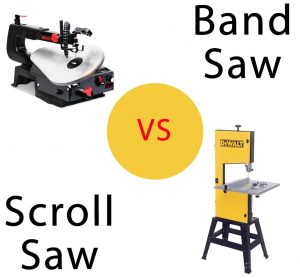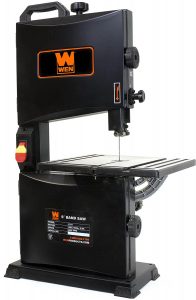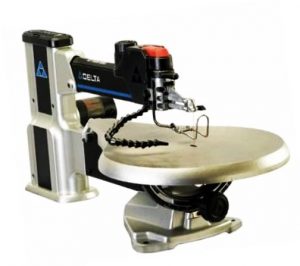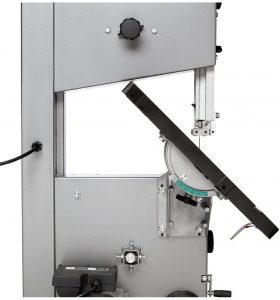Scroll Saw vs Band Saw Review and Comparison [2021]

Scroll Saw vs Band Saw is a frequent problem for the beginner crafters. The winner depends on which tool will make the cut more effectively and/or easier. In our review, we’ll help you determine which features are important to you and which type of saw is best for your project.
Table of Contents
Band Saw vs Scroll Saw: What They are Designed for
Scroll and band saws are generally designed to perform the same work, but the scroll one is used for the finer and smaller cuts and the bandsaw for the bigger cuts.
Band saws are bigger machines capable to cut thick boards, resaw wood, etc. They are designed more for building projects that require thicker material.

The scroll saw is great for inlays, Intarsia, and other small work. It cuts small pieces fine, but even soft pine about 2″ thick go very slow. If you use a great blade like a silicon blade from tuff tooth, it will help a bit, but the weaker motor tends to stop and blow the internal circuit breaker when you try to cut hardwood.
Nevertheless, the scroll saw can do so cleaner and tighter cuts, than a band saw… And its blades are much cheaper unlike the ones for a band saw. There are a lot of blades’ types and they can be switch quick and easy.
Single speed band saws are too fast for metal. Scroll saws are typically variable speed, and you can cut metal with proper blades. The saw wouldn’t cut 1/2″ steel plate, but it can handle small and thin steel and brass parts quite comfortably. For larger metal parts a variable speed jigsaw would work better.
To see the capability of a scroll saw for cutting sheet metal, take a look at the video. Take into account that it looks like he’s using a Hegner which costs about $1500.
Scroll saw is the only tool that will let you back up out of a corner, it will cut both ways with a round blade. Maybe, you need to have both on your shop 🙂
Difference Between Band Saw and Scroll Saw
A bandsaw have a band blade of toothed metal stretched between 2 or 3 (sometimes more) wheels. The minimum radius of a curve is relatively big and is determined by the kerf and width of the band. Band saws have more powerful motors, they can cut thick boards and resaw them. A 14″ band is able to do many jobs and may cost less than $300. Its blades are hard to break and they last long.

The scroll saw is a smaller device for detail work. It uses a thin and narrow reciprocating blades and like a hand coping saw, it can be placed through a pre-drilled starting hole to make interior cutouts without an entry slot. Most scroll saws have relatively low power motors and work without overheating with up to 2″ wood. And I would consider this measurement to be on the optimistic side.
If you purchase a cheap scroll saw you will be wishing that you had gone ahead and bought the band saw. A noname bandsaw will still perform a decent job. So, unless you are ready to spend at least $300 – 500 on the scroll saw, don’t waste your money.
My advice here is a Delta Power scroll saw with electronic variable speed for a wide array of cutting applications. An upper arm of the saw lifts and locks in the raised position during blade changes or while adjusting blade position for fret work. Bevels 0° – 45° left and right.
The tool has minimal vibration, the blade stays put and it works whisper quiet. It is a great unit for fretwork and general purpose cutting. The Delta 40-694 is also pretty similar to the DeWalt DW 788, but costs about $100 less. If you do any amount of scrolling or intricate cuts don’t hesitate to buy this.
Band Saw or Scroll Saw: Pros and Cons
A scroll saw has the advantage for tight curves and internal cuts. Its narrow blade is capable of creating small curves. The intricacy of the shapes can be astonishing, for thin sheet bits of wood or board you’d want a scrollsaw to get into finer corners that a band saw would struggle to achieve. The cuts are so clean, that you often don’t need to sand them, but cutting is very slow.

A main advantage of a band saw is an ability to deal with larger pieces of material. Blades of a band saw are wider and thicker, so I wouldn’t want to make too much fine cuts on a bandsaw. The kerf of the band saw blade allows for some amount of curve, but if it is too tight, the the blade binds in the kerf and may stop the saw. In this case, use a small stone and round off the back corners of your blade after placing it on your band saw. This will make it easier to trim the corners. And since the gullets on a band saw are relatively big, you won’t have a hard time clearing all that saw-dust. For 2″ or thicker pieces, it’s a no-brainer to stick with your bandsaw.
Good example here is a 14″ 1 HP Steel Frame Band Saw by Delta. It has heavy duty steel frame with aluminum trunnion table support. The 1 HP motor works with 2 speeds: 1,620 and 3,340 FPM for cutting wood and non-ferrous metals. The saw is pretty compact and works very quietly and smoothly. Cast iron table is big, sturdy and well-finished. Wood, copper, aluminum, and even stainless will be cut like butter with a proper blades.It is a simple and fairly priced tool, the best choice for those who decide to buy a band saw.
Conclusions
If your typical work is roughing out forms to carve, the band saw is your choice. For precise cuts, a good scroll saw is an indispensable tool. My advice is to purchase a quality scroll saw with a quick-change blade holders. A well-known brand saw will serve you better and retain resale value much longer than an entry-level saw.
Posted on Categories Power tools